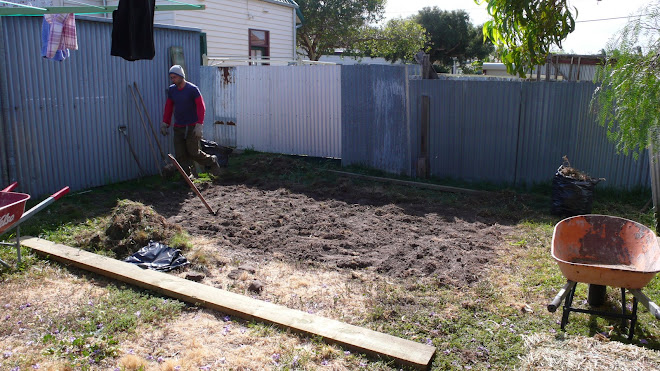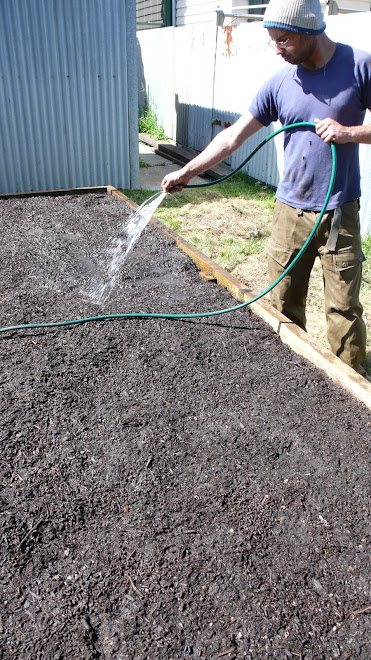In the advent of the current Global situation that faces us, change is more than a thinking process. It requires all of us to become active in many ways.
We are fortunate enough here in Australia that at least 80% of us live on a ground floor. Having a patch of earth at our doorstep is the first vital ingredient in growing our own food.
I believe we all have the opportunity to start partly self sustaining ourselves by growing food in our backyard. Growing organically is an appreciation of simple common sense, such as people have been practicing for centuries.
Organic growing is a more sensible approach to the edible backyard leaving behind the hybrids of the 20th century such as chemical sprays and fertilizers that have done much damage to the environment.
The Key factors to understand when starting to grow our own food are:
(I will go through these topics in detail)
-The preparation of the site….
-Soil & Compost
-Mulch and Green Manures
-Water
-Seasonal Planting & Growing Methods
-Maintenance
Site Preparation
-Soil is the most important ingredient.
-It may take a few planting seasons of composting, green manures and mulch to create a robust soil for plants to really thrive. By doing so veggies grown in a rich structured soil having their own natural resistance to pests and diseases.
-Importing soil into raised beds or as a conditioner on existing patches is the simple way to get your soil nourished for instant planting.
-Most soils have been fumigated with pesticides to rid them of weeds so choose soil carefully,
-Bullen Art & Garden supply fantastic soils and composts.
HUMUS (do we all know what it is)
-A result of a lot of hard work from worms & small insects down to microscopic bacteria and fungi…the entire organisms bi product is the wonderful substance called Humus.
-It gives fertile soil its black colour & earthy smell…unless humus is constantly replaced it vanishes and the soil dies.
-That is the reason why recycling our waste products into compost is essential and considered to be the lifeline of the garden.
Compost
-The compost process breaks down a rich mixture of ingredients to produce potent Humus, which then forms the basis of vigorous plant growth.
-There is something satisfying about making compost, you start with garbage and end up with the most potent soil improver there is.
-In most backyard situation you will have to make do with whatever you have around, otherwise you can buy in materials such as, hay and manure.
- Compost Ingredients include
Grass clipping, fallen leaves, spent veggie plants, weeds, pruning’s, straw, manure, organic kitchen waste, saw dust, ash, fertilizer for example: bone meal, blood and bone
-The 2 broad categories of compost materials are 1.HIGH CARBON (which is woody, brown or dry) 2.HIGH NITOGEN (fresh, wet or green waste)
-The microbes that work in the compost need a starting ratio of approx 30 Carbon to 1 Nitrogen.
A ratio example is: saw dust 45%, paper 15%, straw 10%, leaves 6%, fruit & veggie waste 3%, weeds 2% and chook n cow manure 1% each.
-I helps to have the materials in small pieces also
-The moisture of the compost is extremely important, to dry and the process will stop, to wet and the bacteria will flourish leading to foul smells.
-Oxygen is also required that is why regular turning and if required watering will help maintain the correct balance in your compost.
-2 compost bins can be beneficial storing the finished compost in 1 and the 2nd bin in progress.
-The finished material being (humus) can be applied then covered with a thick layer of mulch.
Mulch & Green Manure
-Green manure crops such as mustard and most legumes release nitrogen into the soil as they grow and while they decompose.
-They are an ideal way of improving the fertility of the soil and increasing productivity of food crops. The crops should be dug into the soil before they become too woody.
- Alternatively you can buy Lucerne in bales and use it dug into the garden or as layering method if starting a raised bed.
-Lucerne can also be use as other mulches such as pea straw & sugar cane on the surface. We want to keep at least 5 cm of mulch on top of the soil at all times.
Water- Set up
-Water has become our greatest concern here in Melbourne, if you are not collecting water you should start doing so.
-Water conservation in the veggie garden is optimized when the soil has been well nourished with organic matter.
-The soil has better water retention along with a heavy layer of mulch on the surface restricting evaporation and encouraging worms to work their way up to the plant roots where it is still cool.
-It is recommended (if you are not irrigating) that water should be applied in greater quantities less often, a generous soaking of up to 15 cm deep encourages deeper root growth.
- A Good sign of when to water is when leaves loose their lustre.
The Wet Pot System
-They consist of porous ceramic bulbs buried beside the plant, slowly seeping water under gravity pressure.
_Water is delivered directly to the root zone of the plant preventing water loss through evaporation or run off.
-The wet pots use between 55% & 75% less water than conventional watering including surface drip irrigation.
-The wet pot has a smart approval watermark recommendation.
-Heavy mulch is still recommended with the wet pot system.
Seasonal Planting- Eating
-One of the largest demands on the agricultural system is our demand for out of season produce; it puts a huge stress on growing methods & infestructure.
-The largest contributors are for example tomatos and broccoli.
-It is our demand to have whatever we like, which fuels this frenzy
-One thing we might like to look at is eating seasonal foods as we have done for centuries.
-It also makes perfect sense that we may only require the nutrients that tomatos give us in summer and the same can be said for broccoli in winter.
I am not insinuating restricting our diet but eating the right foods at the right time of year.
-There are four main planting times to have enough veggies to see you through the year.
Spring, January, autumn, winter
Growing Methods
-There are various ways in which our produce can be grown, including no dig method otherwise called lasagna gardening or traditional soil beds.
-The no dig/lasagna method is much like building your compost, the main ingredient is compost along with multiple layering including mulch, leaves, green manures, newspaper, grass clippings, barn litter or manure.
-The main difference between no dig and traditional soil growing is in its name, no dig low maintenance, you have to keep adding organic material in layers as they decompose.
-Companion Planting
-Is a method of growing plants together, with the idea that they will assist each other for example : deterring pests, improving growth, enhancing flavour, attracting beneficial insects, fixing nitrogen and disrupting patterns.
-This leads to non-structured planting where flowers and veggies should be grouped together also helping to repel weeds.
Some companions are:
Broccoli, good with beans, beetroot carrots, cucumber, potato, sage bad with Garlic, strawberry, tomato
-(sage repels cabbage white butterfly, bad neighbours root release reduce growth)
I have a list for you to look at
-encourage flowers throughout the year
- Crops must also be rotated seasonally deterring soil born pests.
- A simple planting calendar & diary helps create an edible seasonal cycle for planting and rotating crops.
-Build & plant your edible landscape based on your needs, don’t overwork or exhaust yourself creating an enormous garden you cant keep up with.
Maintenance
-Keep compost going at all times constantly adding to it and keeping it moist and air-rated.
-Mulch needs replacing as it starts decomposing.
-Add fresh humus when you start a new planting
-water when your plants need it.
Happy growing
Plant it , grow it , eat it , compost it
- Renato
- inner north, Melbourne, Australia
- Install a veggie garden in your back yard, easy to maintain or i can maintain it for you. -i use only organic veggie seedlings, natural fertilizers and will guide you on your way to Self-Sufficiency. Growing your own food helps to : -Reducing our contributions to climate change- by reducing miles food travels to reach the supermarket. -Water Efficiency- Home grown food has been shown to be more water efficient than broadscale agriculture -Fresh, nutritious, chemical free food -Community Health and Social benefits- Growing food encourages children to eat fruit and veg. Tackles childhood obesity in a health active outdoor activity. -I offer a quick, effective and very reliable service. from bed building, composting, mulching, soil importing, drip irrigation, seed delivery, also available chook pens and more. Start eating your own veggies in 8 weeks. call Renato: 0415 221 517 or email to : urbanveggiegardener@gmail.com Blog : http://urbanveggiegardener.blogspot.com/
Facts for The Edible Backyard
From the Sustainable Living Festival 2009 (please view below)
3 Sleeper high Veggie patch

great height for those who have a sore back


Complete makeover STAGE 1

A barron tasteless lawn!
STAGE 2

Weed & Lawn destruction, soil preperation & conditioning
STAGE 3

Bed Construction
STAGE 4

Green Manure
STAGE 5

Last of the layers before Mulch
STAGE 6

First Plantings
Final result- From a barron lawn to an edible garden.

compact courtyard veggies

Stage 1

Stage 2

Stage 3

final result





Friday, February 20, 2009
Thursday, September 11, 2008
Summer Veggies
Now is the time if you are thinking about installing a veggie garden, or if you need me to maintain your existing veggie garden, i have seedlings ready to plant and plenty of good mulch to spread around.
Friday, September 5, 2008
Time for a change
For centuries we have always reaped our own harvest, now is a time more than any other that we need to continue this ancient tradition. With a backyard small or large we have the ability to sustain our own food production and recycle food wastes into a rich fertile soil.
Keeping our food wholesome and in our own hands is the start being self sufficient.
Subscribe to:
Comments (Atom)
Blog Archive
Our food, our health, our future

what's in my tomato?








